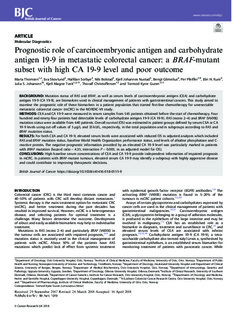| dc.contributor.author | Thomsen, Maria | |
| dc.contributor.author | Skovlund, Eva | |
| dc.contributor.author | Sorbye, Halfdan | |
| dc.contributor.author | Bolstad, Nils | |
| dc.contributor.author | Nustad, Kjell Johannes | |
| dc.contributor.author | Glimelius, Bengt | |
| dc.contributor.author | Pfeiffer, Per | |
| dc.contributor.author | Kure, Elin Wenche Hegland | |
| dc.contributor.author | Johansen, Julia S. | |
| dc.contributor.author | Tveit, Magne Kjell | |
| dc.contributor.author | Christoffersen, Thoralf | |
| dc.contributor.author | Guren, Tormod Kyrre | |
| dc.date.accessioned | 2019-01-29T15:17:33Z | |
| dc.date.available | 2019-01-29T15:17:33Z | |
| dc.date.created | 2018-06-23T12:40:14Z | |
| dc.date.issued | 2018 | |
| dc.identifier.citation | British Journal of Cancer. 2018, 118 (12), 1609-1616. | nb_NO |
| dc.identifier.issn | 0007-0920 | |
| dc.identifier.uri | http://hdl.handle.net/11250/2582930 | |
| dc.description.abstract | Background
Mutation status of RAS and BRAF, as well as serum levels of carcinoembryonic antigen (CEA) and carbohydrate antigen 19-9 (CA 19-9), are biomarkers used in clinical management of patients with gastrointestinal cancers. This study aimed to examine the prognostic role of these biomarkers in a patient population that started first-line chemotherapy for unresectable metastatic colorectal cancer (mCRC) in the NORDIC-VII study.
Methods
CEA and CA 19-9 were measured in serum samples from 545 patients obtained before the start of chemotherapy. Four hundred and ninety-four patients had detectable levels of carbohydrate antigen 19-9 (CA 19-9). RAS (exons 2–4) and BRAF (V600E) mutation status were available from 440 patients. Overall survival (OS) was estimated in patient groups defined by serum CEA or CA 19-9 levels using cut-off values of 5 µg/L and 35 kU/L, respectively, in the total population and in subgroups according to RAS and BRAF mutation status.
Results
For both CEA and CA 19-9, elevated serum levels were associated with reduced OS in adjusted analyses which included RAS and BRAF mutation status, baseline World Health Organization performance status, and levels of alkaline phosphatase and C-reactive protein. The negative prognostic information provided by an elevated CA 19-9 level was particularly marked in patients with BRAF mutation (hazard ratio = 4.35, interaction P = 0.003, in an adjusted model for OS).
Conclusions
High baseline serum concentrations of CEA and CA 19-9 provide independent information of impaired prognosis in mCRC. In patients with BRAF-mutant tumours, elevated serum CA 19-9 may identify a subgroup with highly aggressive disease and could contribute to improving therapeutic decisions. | nb_NO |
| dc.language.iso | eng | nb_NO |
| dc.publisher | Springer Nature | nb_NO |
| dc.rights | Navngivelse 4.0 Internasjonal | * |
| dc.rights.uri | http://creativecommons.org/licenses/by/4.0/deed.no | * |
| dc.title | Prognostic role of carcinoembryonic antigen and carbohydrate antigen 19-9 in metastatic colorectal cancer: a BRAF-mutant subset with high CA 19-9 level and poor outcome | nb_NO |
| dc.type | Journal article | nb_NO |
| dc.type | Peer reviewed | nb_NO |
| dc.description.version | publishedVersion | nb_NO |
| dc.source.pagenumber | 1609-1616 | nb_NO |
| dc.source.volume | 118 | nb_NO |
| dc.source.journal | British Journal of Cancer | nb_NO |
| dc.source.issue | 12 | nb_NO |
| dc.identifier.doi | 10.1038/s41416-018-0115-9 | |
| dc.identifier.cristin | 1593416 | |
| dc.description.localcode | This is a published version of an article published in British Journal of Cancer. Locked until 6.6.2019 due to copyright restrictions. The final authenticated version is available online at:https://doi.org/10.1038/s41416-018-0115-9 | nb_NO |
| cristin.unitcode | 194,65,20,0 | |
| cristin.unitname | Institutt for samfunnsmedisin og sykepleie | |
| cristin.ispublished | true | |
| cristin.fulltext | original | |
| cristin.qualitycode | 2 | |

